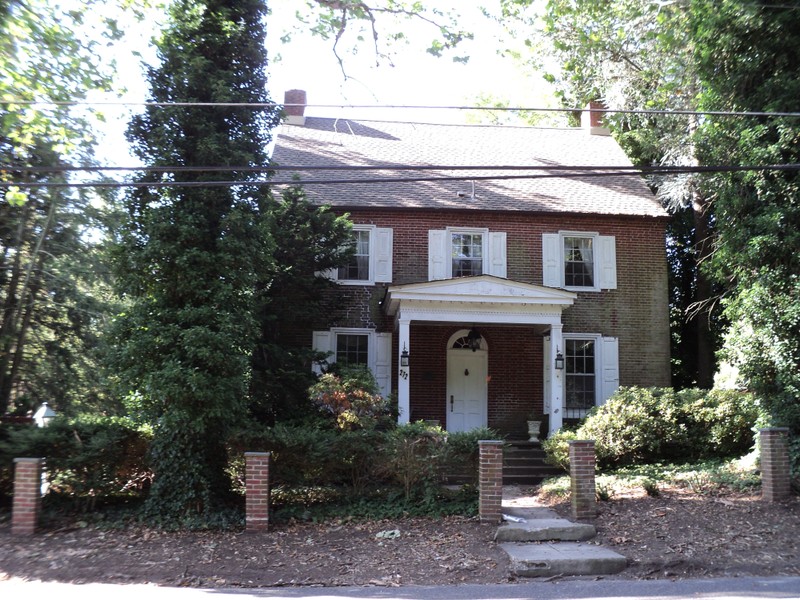Miller's House (The Nehemiah Haines House)
Introduction
Text-to-speech Audio
Images
Miller's House (The Nehemiah Haines House)

Backstory and Context
Text-to-speech Audio
Nehemiah Haines, great-great-grandson of Richard Haines, who in 1682 received a land patent in southern New Jersey from the Duke of York (later King James II), built the charming brick home in 1785 for his son Charles. The dwelling is associated with the Haines Mill that Nehemiah's older brother, Issac, opened in 1778. The historic home remained in the Haines family until the Kirby family purchased the mill property in 1877.
By arriving early to Burlington County and gaining ownership of the woodlands and watersheds, The Haines Family exhibited inordinate influence in Burlington County. Richard's son, John, married Esther and built a farmstead home in 1690. The couple had thirteen children who, along with generations of other children, constructed more homes in the area, amassed thousands of acres of land. John's great-grandson (Richard's great-great-grandson), Issac, opened in 1778 what is now Kirby's Mill (now operated by Medford Historical Society). The Haines 1 Mill, a hydro-powered saw and grist mill, ground grain for the Continental Army during the Revolutionary War and provided the army with both flour and gun powder.
Issac's younger brother, Nehemia, built the home across the street from the mill for his son Charles in 1785. Twenty-five years later, around 1830, Charles doubled the mill's size from its original single story (with a loft) to a three-story structure. Charles likely added the Blacksmith shop and small barn about the same time. For more than a century, the mill served as Medford's commerce center, with more business transactions taking place than anywhere in the township. There was in operation the sawmill, shingling mill, grist mill, Blacksmith shop, wheelwright shop, carding mill, cider mill, and still house. The mill's success only furthered the influence and wealth of the Haines family throughout the nineteenth century.
William Kirby bought the Haines mill property in 1877. Because many owners of the Haines/Kirby's Mill lived in the home built by Nehemia, it gained the nickname: "Miller's House." The house today survives both as a lasting reminder of the influential Haines family history in Medford and the prosperity that could be gained by milling in New England. Indeed, both the Haines and Kirby families enjoyed financial success by owning the mill. While no longer part of the Kirby's Mill complex, the home is intrinsically part of Haines and mill history.
Sources
Coughlin, Bill. "The Nehemiah Haines House" The Historical Marker Database. hmdb.org. 2020, 2011. https://www.hmdb.org/m.asp?m=44660.
"John Haines House, #20." West Jersey History Project. westjerseyhistory.org. Accessed February 19, 2021. http://www.westjerseyhistory.org/books/medsites/.
"Haines House." South Jersey Magazine: southjersey.com. Accessed February 21, 2021. https://www.southjersey.com/article/5517/Haines-Mill.
"Kirby's Mill." Medford Historical Society. medfordhistory.org. Accessed February 21, 2021.
M, Ben and Mathew Powers. "Kirby's Mill - Haines Mill (Modern: Medford Historical Society)." Clio: Your Guide to History. February 21, 2021. Accessed February 21, 2021. https://www.theclio.com/entry/21352
Mitchell, Gail Grossmick. "The Haines Tree." The Haines Family of New Jersey. Accessed February 19, 2021. https://southjersey.weebly.com/haines-tree.html.
Powers, Mathew. "John Haines House (Friendship Farm)." Clio: Your Guide to History. February 20, 2021. Accessed February 21, 2021. https://www.theclio.com/entry/127042.
Powers, Mathew. "Jonathan Haines House." Clio: Your Guide to History. February 20, 2021. Accessed February 21, 2021. https://www.theclio.com/entry/127071.
Trumbower, Betty H and James G Trumbower. "Nomination Form: Jonathan Haines House - Friendship Farm." National Register of Historic Places. nps.gov. 1976. https://npgallery.nps.gov/GetAsset/89556d1f-4ae2-4ed1-9956-4b508e5ea2c6/. Though this form references Jonathan Haines, its subject is John Haines, the builder of the 1690 farmhouse on Fostertown Road. Nevertheless, the material provided gives insight into the Haines family, including Jonathan, who built the 1760 structure.
The Historical Marker Database https://www.hmdb.org/m.asp?m=44660
